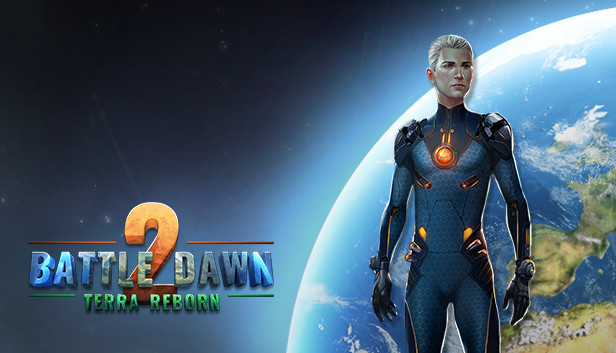For Battle Dawn 2: Terra Reborn players, this guide will cover basics within the battle system assuming a completely vanilla state
Introduction
Battle Dawn offers an array of units, weapons, and attributes, and it’s important to know how to use them all efficiently. This guide is not all-encompassing but will get into the functionality of battles and how to set up scenarios that benefit different builds of units. We will also assume that no avatar buffs are present and later acknowledge how powerful avatar items and buffs can be in swinging a battle.
Unit bonuses and Weapon types
Let’s first review the basics of units. Tigerfangs(TF) with the Crabzilla(C) attribute do 2 damage, have 8 hp, and 1 range. With the Batcroc(B) attribute they do 7 damage, have 6 hp, and 2 range, and finally with the Porcubear(P) attribute they do 4 damage, have 4 hp, and 3 range. Octosharks(OS) are the same with all attributes regarding range, but their hp and damage are doubled. Mammothsloths(MS) are the same with all attributes regarding range, but their hp and damage are tripled. TFs innately do 125% damage vs OS, and OS innately do 125% damage vs MS. MS do not get a bonus damage modifier.
Then, there are 3 weapon types to consider. Flamethrowers(F) will do 100% vs TF, 50% vs OS, and 25% vs MS. Machineguns(MG) will do 25% vs TF, 100% vs OS, and 50% vs MS. Rocketlaunchers(RL) will do 50% vs TF, 25% vs OS, and 100% vs MS.
With all this information we can perform some basic calculations. A TF equipped with an MG and the B attribute will do 8.75 damage to OS, but 1.75 damage to MS, and 3.5 damage to TF. So, depending on the body your opponent prefers there could be a swing of 7 damage that your units actually do. Another point to note is that in this scenario the TF described has a reported damage of 7, but in actuality does more or less than 7 damage.
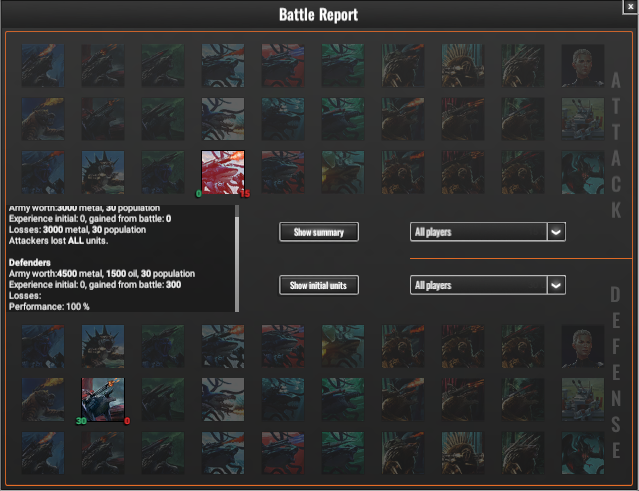
If there was no damage modifier applied due to the unit types, 1 OS would’ve lived in the first round. As we can see though, all 15 OS units die.
Range and Targeting
It is also important to consider range. In the first round, only units with the P attribute will fire. In the second round, units with the P attribute and B attribute will fire, and finally in the third round all units will fire. This means that units with the P attribute will have done more damage than units with the B attribute in the second round, but units with the B attribute will have done more damage than units with the P attribute in the third round.
Finally, we’ll consider targeting. Units will always target units with the C attribute first, then the B attribute, and finally the P attribute. Units will target the F weapon type, then the MG weapon type, and finally the RL weapon type. Units with the F weapon will target TF units first, MG weapons will target OS units first, and RL weapons will target MS units first. The priority order works like this: Unit type, attribute, then weapon type. Units will target the unit type they do most damage to, then the lowest range attribute, then lowest HP unit, then weapon type from F to MG to RL.
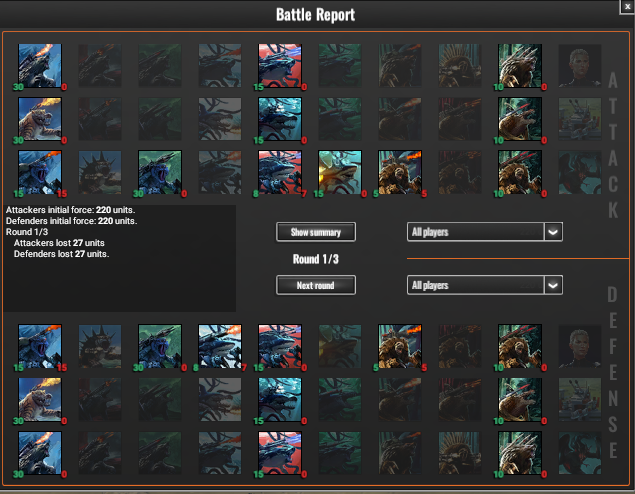
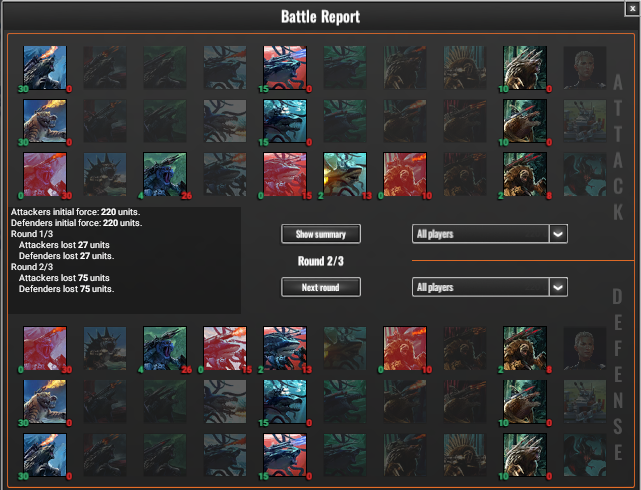
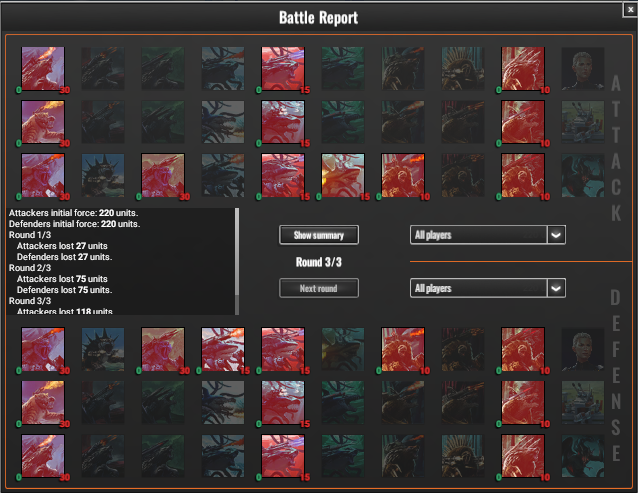
Look very carefully at what units die first and in what amount. The behavior described above works perfectly in this example.
Efficient Builds
We can draw multiple conclusions from this data. In order to efficiently beat an enemy, the weapon type and unit type are the most important things to consider. Then we must consider how many rounds we predict the battle to be. If we predict a battle to last 3+ rounds, then we want some mixture of B attribute and C attribute, if we predict a battle to last only 2 rounds, then we want some mixture of P attribute and C attribute. In general, we don’t want to mix all 3 as it would not be efficient. We also want to be only 1 unit type, as if we were to build an army with all 3 unit types, we will be taking 100% or more damage from all weapons.
There are many ways to hamper an enemy before going into a battle. Nukes will bring all units down to 1 HP and put radiation on outposts that will perform 1 damage every half interval (in a 1x speed this would be every 30 minutes). Spies can perform functions that will bring all TF down to 1 hp, or do half damage to OS or MS units. Ions will bring 10 random units down to 1 HP, or delay a squad by 1 interval and bring that entire squad down to 1 HP. As there are a plethora of ways to hamper an enemy, we seem more drawn to building our army in a mix of P attribute and C attribute, as it is likely we can hamper our enemy before we engage with them.
Consider a scenario where the enemy we fight avoids scenarios of them being hampered, then it would be best to build our army in a mix of B attribute and C attribute.
Then we must consider what our composition should be. There is no actual perfect composition of our army that would result in the most efficient battle in all scenarios. If we have an army of P attribute and C attribute, and we predict our battle to be 1 round, then we only need enough C attribute to shield our P attribute units from taking damage. Conversely if we have an army of B attribute and C attribute, and we predict our battle to be 4 rounds, then we need enough C attribute to shield our B attribute units to ensure they will fire on round 4.
If we do many calculations the preferred ratio of P attribute units to C attribute units seems to be in the range of 2:1 to 3:1 P:C. The preferred ratio of B attribute units to C attribute units seems to be in the range of 1:1 to 2:1 B:C.
These are only theoretical builds, as such none of these builds have really been tested with all of the nuances that avatars and other modifiers bring. As such, these are merely vanilla-based projections of what resource-efficient builds would look like.
Vampire Cobras and Avatars
Finally let’s consider vampire cobras. Vampire Cobras(VC) will revive units every round. There’s a limit on how much they can revive the same unit and for how many rounds. They cannot revive units if they are not dead at the beginning of the round, meaning their first revival will happen on round 2. This means that it most efficient to have enough VC that the C attribute units are revived every round of combat. However, this is very expensive to do.
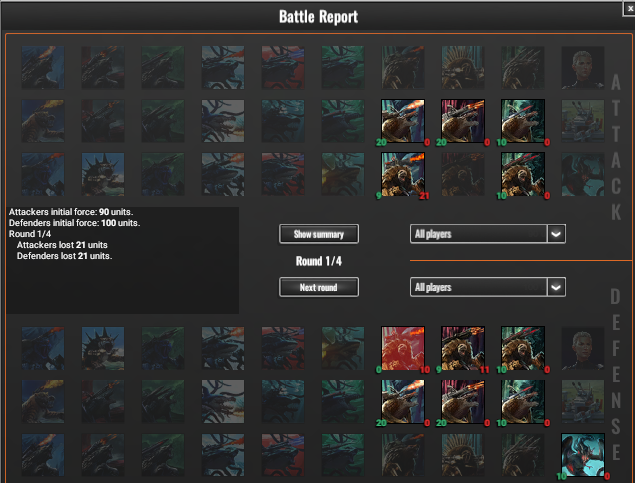
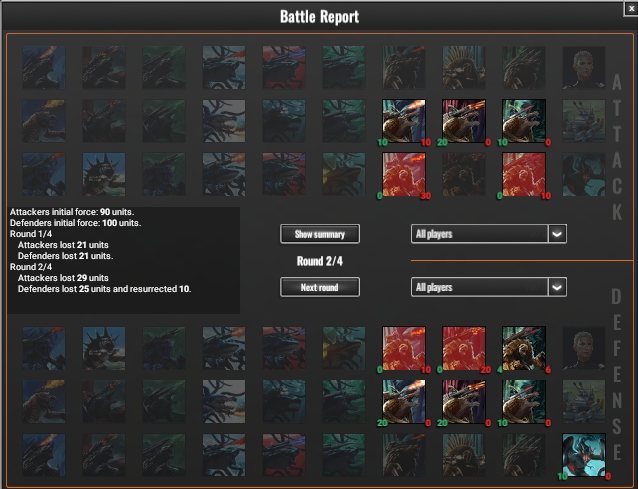

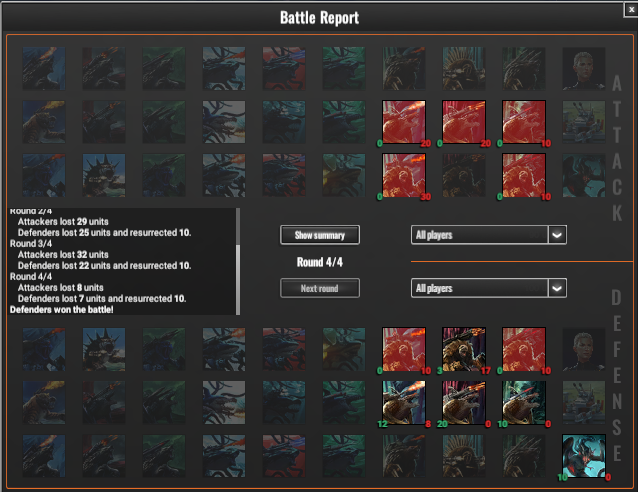
Note that units that get revived during combat will die after combat. Also that this is a very plain battle, other battles involving VCs may see different results regarding how many units get revived per round.
Now, the most unpredictable but potentially the most important thing we must consider is the presence of Avatars. As you play the game and battle other commanders with your Avatar leading the charge, your Avatar will gain experience. This will allow you to gain damage modifiers and defense modifiers. Your Avatar can also equip items which can give bonus modifiers in combat. All of these modifiers stack. Meaning if 10 avatars are present in battle and all 10 avatars have a 10% damage modifier, therefore the entire army will do 100% more damage. You cannot see what bonuses your opponents’ avatars have outside of what items they have equipped. This means you must very carefully consider fighting an opponent or opponents that have their Avatars present. It is also worth pointing out that the defensive bonus can only make units perform a minimum of 10% damage.
To put it bluntly whether to choose the damage modifier or defense modifier is a very complicated choice. There are times when damage modifiers matter, and defense modifiers matter. If you are in a battle that you will lose to your opponent’s damage, then defense modifiers are needed in order to prolong the battle thus cause more damage yourself. On paper it seems that damage modifiers are the general best option, but there are many scenarios in which defense modifiers would be more beneficial. Imagine scenarios to where you know how much damage modifiers your opponent has – you could negate them by putting up enough defense modifiers thereby allowing you to take far less losses. There are also scenarios to where you have taken damage in the form of a spy, or nuke radiation where your opponent may think they have enough damage to take minimal losses, but defense modifiers could cause more rounds to occur.
In conclusion with all this data, battles are very complicated to predict. We can create situations in which our build is optimal, but we must consider carefully what the battle will look like and who we are facing.
